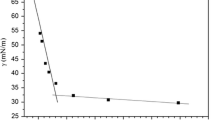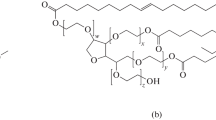Abstract
To determine the exact role of various factors in silicone-oil emulsification, we investigated eight different silicone oils with specific physicochemical characteristics in terms of their rate of emulsification. The silicone oils were defined by viscosity, volatility, amount of low-molecular components, electrical resistivity, degree of purification and chemical composition. The viscosities differed between the ranges of 1000 and 10000 cs. The silicone oils included purified polydimethylsiloxane (PDMS), hydroxyl-enriched PDMS and trimethylsiloxy-terminated polydiphenylsiloxane (PDPS). As emulsifiers we used 0.1% solutions of fibrinogen, fibrin, gamma globulins, acidic alpha-1-glycoprotein, very-low-density lipoprotein and serum dissolved in sterile, distilled water as well as in balanced salt solution. The group of low-viscosity silicone oils (1000 cs) was least stable. The greatest difference in stability was found among purified PDMS, having viscosities between 1000 and 5000 cs. The most stable oil was purified PDMS, whose emulsification rate was almost identical at 5000 and 10 000 cs. High contents of hydroxyl end groups enhanced silicone-oil emulsification to a greater extent than did phenyl side groups. The strongest emulsifiers were fibrinogen, fibrin and serum, followed by gamma globulins, very-low-density lipoprotein and acidic alpha-1-glycoprotein. Balanced salt solution accelerated silicone oil emulsification in all cases. For reduction of emulsification in vivo, purified PDMS of high viscosity should be used. Biologically active emulsifiers found in hemorrhages or inflammatory situations might be lowered in vivo by hemostasis and sufficient postoperative anti-inflammatory therapy.
Similar content being viewed by others
References
Blodi FC (1971) Injection and impregnation of liquid silicone into ocular tissues. Am J Ophthalmol 71:1044–1051
Carstensen JT, Su K (1984) Physikalische und chemische Faktoren bei der Entwicklung von dispersen Systemen. In: Asche H, Essig D, Schmidt PC (eds) Technologie von Salben, Suspensionen und Emulsionen. Wissenschaftliche Verlagsgesellschaft, Stuttgart, pp 15–31
Cibis PA, Becker B, Okun E, Canaan S (1962) The use of liquid silicone in retinal detachment surgery. Arch Ophthalmol 68:590–599
Crisp A, Juan E de, Tiedeman J (1986) Effect of silicone oil viscosity on emulsifications. Arch Ophthalmol 105: 546–550
Gabel V-P, Kampik A, Burkhardt J (1987) Analysis of intraocularly applied silicone oils of various origins. Graefe's Arch Clin Exp Ophthalmol 225:160–162
Heidenkummer H-P, Kampik A, Thierfelder S (1990) Experimentelle Untersuchungen zum sogenannten Emulsifikationsverhalten von Silikonöl: Einfluß der Viskosität. Fortschr Ophthalmo1 87:226–228
Honda Y, Ueno S, Miura M, Yamaguchi H (1986) Silicone oil particles trapped in the subretinal space: complications after substitution of the vitreous. Ophthalmologica 192:1–5
Kampik A, Gabel V-P, Spiegel D (1984) Intraokulare Tamponade mit hochviskösem Silikonöl bei massiver proliferativer Vitreoretinopathie (PVR). Klin Monatsbl Augenheilkd 185:368–370
Kirchhof B, Tavakolian U, Paulmann H, Heimann K (1986) Histopathologic findings in eyes after silicone oil injection. Graefe's Arch Clin Exp Ophthalmol 224:34–37
Kreiner CF (1987) Chemical and physical aspects of clinically applied silicones. Dev Ophthalmol 14:11–19
Lagaly G (1984) Energetische Wechselwirkungen in Dispersionen und Emulsionen. In: Asche H, Essig D, Schmidt PC (eds) Technologie von Salben, Suspensionen und Emulsionen. Wissenschaftliche Verlagsgesellschaft mbH, Stuttgart, pp 32–61
Laqua H, Lucke K, Foerster MH (1988) Entwicklung und gegenwärtiger Stand der Silikonölchirurgie. Klin Monatsbl Augenheilkd 192:277–283
Manschot WA (1978) Intravitreal silicone injection. Adv Ophthalmol 36:197–207
Nakamura K, Refojo MF (1988) Factors contributing to emulsification of intraocular silicone and fluorosilicone oils. Invest Ophthalmol Vis Sci 29 [Suppl]:405
Ni C, Wang W-J, Albert DM, Schepens CL (1983) Intravitreous silicone oil injection. Histopathologic findings in a human eye after 12 years. Arch Ophthalmol 101:1399–1401
Refojo MF, Leong F-L, Chung H, Ueno N, Nemiroff B, Tolentino FI (1988) Extraction of retinol and cholesterol by intraocular silicone oils. Ophthalmology 95:614–618
Schepens CL (1987) Vitreous substitutes and vitreous surgery. Bull Soc Belge Ophthalmol 223:273–301
Scott JD (1975) The treatment of massive vitreous retraction by the separation of pre-retinal membranes using liquid silicone. Mod Probl Ophthalmol 15:285–290
Zivojnovic R, Mertens DA, Peperkamp E (1982) Das flüssige Silikon in der Amotiochirurgie: II. Bericht über 280 Fälle —weitere Entwicklung der Technik. Klin Monatsbl Augenheilkd 181:444–452
Author information
Authors and Affiliations
Additional information
Offprint requests to: H.-P. Heidenkummer
Rights and permissions
About this article
Cite this article
Heidenkummer, HP., Kampik, A. & Thierfelder, S. Emulsification of silicone oils with specific physicochemical characteristics. Graefe's Arch Clin Exp Ophthalmol 229, 88–94 (1991). https://doi.org/10.1007/BF00172269
Received:
Accepted:
Issue Date:
DOI: https://doi.org/10.1007/BF00172269




